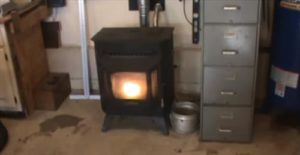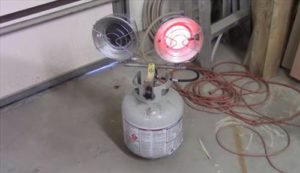
Heating a garage with little to no insulation can be challenging, but there are some good options.
Every garage will be different, with some having the roof insulated but none in the walls, while others have none at all.
With the many options to choose from, here are some ideas and our picks for options to heat up a cold garage.
As always, be sure to read the reviews on Amazon, forums, or elsewhere to be sure a unit is a good fit for you.
*This site contains affiliate paid links for which a commission earned.
Our Picks for Best Heaters for a Non-Insulated Garage?
- Propane Heaters
- Wood Stove
- Mini Split
- Ceiling Mount Heaters
- Kerosene Forced Air Heaters
Available Here on Amazon
The downside to a propane heater is it needs a door cracked open to refresh the oxygen in a room. This likely isn’t a problem in a garage with no insulation, but every garage is different.

Another downside is having to refill propane tanks constantly. A standard 5-gallon propane tank will last 2-3 days of constant use, which isn’t bad considering how much heat they put out.
If you go this route, it is best to have at least two propane tanks or at least one large 20-gallon tank or more.
Keep in mind propane tank heaters burn up the oxygen in a room, which can be dangerous if there is no opening for more oxygen to get in.
Wood stoves are a good option for those who have ready access to a supply of wood.
If you live in a heavily wooded area, you likely have already thought of this and may have a stove in place.
Others may live in a place where wood is expensive or a city that doesn’t allow wood burning.
Mini split units are likely the best options since they a quiet, low-cost to operate, and also cool during the summer.
The downside to a mini-split is the installation cost to install and set up. Most HVAC companies will charge 2000$-3000$ to install a mini split.
If you are a handy type of person and can do the installation yourself, there are many DIY mini-split installation kits.
There are many DIY mini split install videos on YouTube and website tutorials that make installation easier.
Unfortunately, for most, the higher cost of a mini split unit puts it out of reach, but it is a nice thing to have when installed.
Read Here for Our Picks for the Best DIY Mini Split Systems
Available Here on Amazon
Electrical units are also good heaters to use, which come in all shapes and sizes.
The downside to electrical is they can run up an electric bill when used a lot.
Even though they are not that efficient, they are low-cost, easy to set up units that will be heating up a space in no time.
Kerosene-forced air heaters put out a lot of heat and are only used in open spaces.
They are often set up at construction sites in buildings to help while floating and taping drywall when it becomes too cold.
Like propane heaters, they use up oxygen, so a door will need to be open while using one.
A Kerosene heater will likely be overkill for the average garage since they put out so much heat. Only areas with very cold winters would one even be thought of being used.
Summary
There are several options for heating and cooling a garage that has no insulation.
If you have the money, then a mini-split is probably the best choice; unfortunately, it is also the most expensive.
Propane and electric also are good units for those looking to quickly start heating a garage.
Always keep in mind safety as with any fire hazard or the oxygen a unit uses.
Be sure to read the reviews on Amazon or elsewhere to be sure a unit is a good fit for you.
START by installing radiant barrier… especially beneath the rafters of a garage that has its own roof. This is a passive system that takes some trouble and expense to install, but the operating cost is zero. Learn about the virtues of radiant barriers… which are NOT insulation, but which block the transfer of heat by infra-red radiation… the invisible means that defies most people’s understanding. Thus, especially in low-humidity areas… (west of the Mississippi), the radiant barrier is the vastly missed opportunity, towards efficient comfort… keeps a garage warmer at night, and cooler during the daytime.
Shiny side down! If it gets dull, its effectiveness is diminished.